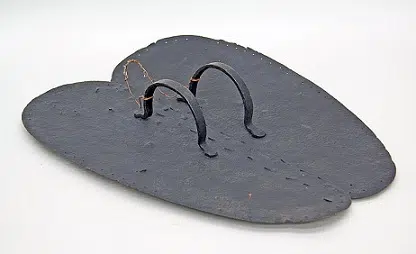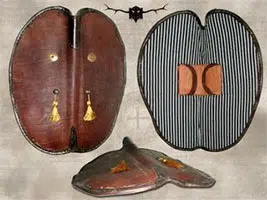 The term adarga comes from the Hispanic Arabic addárqa , in turn derived from the classical Arabic daraqah . An oval or heart-shaped shield that is made of leather is called a buckler.
The term adarga comes from the Hispanic Arabic addárqa , in turn derived from the classical Arabic daraqah . An oval or heart-shaped shield that is made of leather is called a buckler.
The origins of the shields must be sought in Al-Andalus , when they were used by the Muslims who made up the cavalry . As time went by, these shields also began to be used by Christians , both in cavalry and infantry.
Let us remember that Al-Andalus is what the Muslims called the Iberian Peninsula. Depending on the author, we will find descriptions that more or less limit the meaning of this term in terms of the extent of territory it represented, and this range goes from the peninsula to parts of present-day France, Gibraltar and Andorra.
The origin of this shield was on the African continent, more precisely in the north. This was because the most important manufacturing center of the shield was in Fez , a very important city in Morocco, considered the capital of Islam and located among the four so-called imperial cities , a group to which Rabat, Meknes and Marrakech also belong. .
The shield provided effective protection against attacks from arrows , spears and swords . Starting in the 16th century , when firearms began to be used, they began to lose preponderance since they were not useful to defend against this type of offensive.
In any case, shields continued to serve because spears and swords remained valuable in combat until firearms achieved greater loading speeds. Thanks to having a handle, handling was easy.
In this context, the creation of the bayonet , a bladed weapon that surpassed the spear and sword in popularity, was also significant. Its main attraction was the possibility of attaching it to a firearm, which enhanced its usefulness and provided the opportunity to attack quickly and effectively in a hand-to-hand encounter, when there was not enough time to reload the barrel or more were needed. blows to defeat the enemy.
 The shield was widely used in reed games , which have their origin in the ancient Arab armies and were practiced very frequently in Spain between the 16th and 18th centuries, in almost all of its current main squares. In short, it was a simulation of combat between the members of the same platoon, who had to be divided into two groups, all mounted on horses: some threw darts or spears at the opponents, who had to stop them with the buckler.
The shield was widely used in reed games , which have their origin in the ancient Arab armies and were practiced very frequently in Spain between the 16th and 18th centuries, in almost all of its current main squares. In short, it was a simulation of combat between the members of the same platoon, who had to be divided into two groups, all mounted on horses: some threw darts or spears at the opponents, who had to stop them with the buckler.
It was also necessary for the game of running piggy banks , in which riders threw piggy banks full of flowers or ashes at their opponents, who had to try to stop them with their bucklers. While large bucklers of variable firmness were used for the cane game so that they would bend when resting on the horse's body, in the piggy bank game they were covered with fine wood so that they would break into pieces upon impact.
We can find the concept of a shield in “Don Quixote de la Mancha” , the most famous work of Miguel de Cervantes . At the beginning of the book , Cervantes speaks of a “hidalgo” with an “ancient buckler.” However, when adapting the work to modern Spanish, in some versions it was decided to replace this expression with “ancient shield” .
In this way, we sought to facilitate the understanding of history for contemporary readers. However, there are those who warned that the change caused the loss of the original meaning, linked specifically to the shield whose frame was composed of folded skins that were sewn and glued.
